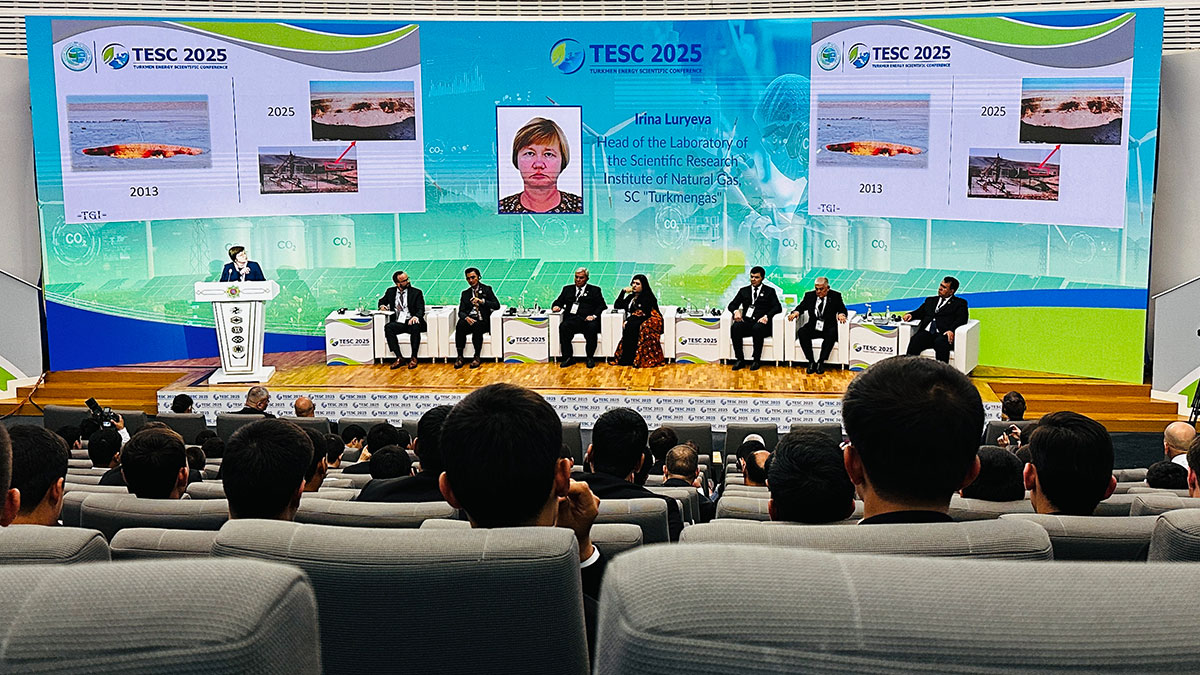Turkmenistan's achievements in reducing methane emissions announced at TESC 2025
Innovative monitoring and impressive results in reducing methane emissions in Turkmenistan were presented at the International Scientific and Practical Conference “Environmental Aspects of the Implementation of Innovative Technologies in the Development of Hydrocarbon Deposits” (TESC 2025) in Ashgabat. Irina Luryeva, Head of the laboratory of the Scientific Research Institute of Natural Gas of the State Concern “Turkmengaz”, spoke in detail about the achievements of the country in her report. Since joining the Global Commitment to Reduce Methane Emissions, Turkmenistan has been actively demonstrating its commitment to combating climate change. The country has set an ambitious goal to reduce methane emissions by at least 30% by 2030 compared to 2020 levels. This is confirmed by the approved Roadmap and consistent compliance with international environmental programs such as the UN Framework Convention on Climate Change and the Paris Agreement. In order to effectively control methane emissions, Turkmenistan launched a joint project with the United Nations Environment Programme (UNEP) in March 2024. As part of this collaboration, satellite data has begun to be systematically received on the MARS digital platform (a system for Preventing and Responding to Methane Emissions), which makes it possible to track sources of emissions in real time. The system has already proven its effectiveness. In November and December 2024, MARS did not record any cases of methane emissions at all gas production departments of the State Concern “Turkmengas”, which indicates the success of preventive measures and constant monitoring. One of the most striking examples of the efforts of Turkmenistan was a significant reduction in emissions on the famous Darvaz gas crater. This crater, formed as a result of an accident during the drilling of a reconnaissance well, burned for decades, being a serious source of methane emissions. Initially, it was set on fire to prevent gas poisoning, however, due to the multi-layered structure of the deposit, gas supply continued. Now the situation is changing dramatically. Specialists from the Natural Gas Research Institute have developed and are successfully implementing a Work Program at the Chaljulba field, of which the crater is a part. Previously mothballed wells have been developed and put into operation. The receipt of low-pressure gas and weakly gasified formation water from different wells indicates a decrease in the crater's gas supply. The results were not long in coming. New high-flow wells were drilled near the crater, which significantly increased gas extraction. Since December 2024, two wells have already been in operation, and the monthly rate of gas extraction has increased several times. Currently, the next stage of the program has begun, including the deconservation of other wells, and drilling of another new well with a high gas inflow was completed in February 2025. This has a visible effect. If in 2013 the glow from the Darvaza gas crater was visible for many kilometers, now its burning can only be seen in the immediate vicinity. These positive changes are confirmed by independent satellite data obtained from the company Capterio. Their integrated multi-sensor data, tracking the combustion and emissions of methane from the Darvaza crater over many years, show a significant reduction in emissions. During the analyzed period, the intensity of unorganized burning of the crater decreased by more than 3 times. The study demonstrates how combining different data sources can help inform decision-making and create a universal model for reducing emissions even in the most challenging conditions. Turkmenistan's commitment to environmental sustainability is evident not only in major projects, but also in annual scientific conferences dedicated to innovative environmental solutions in the oil and gas industry. Although oil and natural gas are projected to play a key role in the global energy mix until 2050, Turkmenistan is aware that the priority is not only production, but also the rational use of resources with a constant reduction of harmful effects on the environment.

